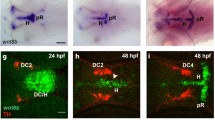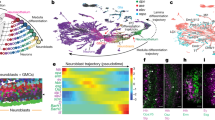Abstract
The mechanism controlling the development of dopaminergic (DA) and serotonergic (5HT) neurons in vertebrates is not well understood. Here we characterized a zebrafish mutant—too few (tof)—that develops hindbrain 5HT and noradrenergic neurons, but does not develop hypothalamic DA and 5HT neurons. tof encodes a forebrain-specific zinc finger transcription repressor that is homologous to the mammalian Fezl (forebrain embryonic zinc finger–like protein). Mosaic and co-staining analyses showed that fezl was not expressed in DA or 5HT neurons and instead controlled development of these neurons non-cell-autonomously. Both the eh1-related repressor motif and the second zinc finger domain were necessary for tof function. Our results indicate that tof/fezl is a key component in regulating the development of monoaminergic neurons in the vertebrate brain.
This is a preview of subscription content, access via your institution
Access options
Subscribe to this journal
Receive 12 print issues and online access
$209.00 per year
only $17.42 per issue
Buy this article
- Purchase on Springer Link
- Instant access to full article PDF
Prices may be subject to local taxes which are calculated during checkout





Similar content being viewed by others
Accession codes
References
Kandel, E.R., Schwartz, J.H. & Jessell, T.M. Principles of Neural Science 1135 (Elsevier, New York, 1991).
Ye, W., Shimamura, K., Rubenstein, J.L., Hynes, M.A. & Rosenthal, A. FGF and Shh signals control dopaminergic and serotonergic cell fate in the anterior neural plate. Cell 93, 755–766 (1998).
Zetterstrom, R.H. et al. Dopamine neuron agenesis in Nurr1-deficient mice. Science 276, 248–250 (1997).
Saucedo-Cardenas, O. et al. Nurr1 is essential for the induction of the dopaminergic phenotype and the survival of ventral mesencephalic late dopaminergic precursor neurons. Proc. Natl. Acad. Sci. USA 95, 4013–4018 (1998).
Smidt, M.P. et al. A second independent pathway for development of mesencephalic dopaminergic neurons requires Lmx1b. Nat. Neurosci. 3, 337–341 (2000).
Simon, H.H., Saueressig, H., Wurst, W., Goulding, M.D. & O'Leary, D.D. Fate of midbrain dopaminergic neurons controlled by the engrailed genes. J. Neurosci. 21, 3126–3134 (2001).
Guo, S. et al. A regulator of transcriptional elongation controls vertebrate neuronal development. Nature 408, 366–369 (2000).
Dittrich, R., Bossing, T., Gould, A.P., Technau, G.M. & Urban, J. The differentiation of the serotonergic neurons in the Drosophila ventral nerve cord depends on the combined function of the zinc finger proteins Eagle and Huckebein. Development 124, 2515–2525 (1997).
Lundell, M.J. & Hirsh, J. eagle is required for the specification of serotonin neurons and other neuroblast 7-3 progeny in the Drosophila CNS. Development 125, 463–472 (1998).
Ye, W. et al. Distinct regulators control the expression of the mid-hindbrain organizer signal FGF8. Nat. Neurosci. 4, 1175–1181 (2001).
Hynes, M., Poulsen, K., Tessier-Lavigne, M. & Rosenthal, A. Control of neuronal diversity by the floor plate: contact-mediated induction of midbrain dopaminergic neurons. Cell 80, 95–101 (1995).
Guo, S. et al. Mutations in the zebrafish unmask shared regulatory pathways controlling the development of catecholaminergic neurons. Dev. Biol. 208, 473–487 (1999a).
Akimenko, M.A., Ekker, M., Wegner, J., Lin, W. & Westerfield, M. Combinatorial expression of three zebrafish genes related to distal-less: part of a homeobox gene code for the head. J. Neurosci. 14, 3475–3486 (1994).
Barth, K.A. & Wilson, S.W. Expression of zebrafish nk2.2 is influenced by sonic hedgehog/vertebrate hedgehog-1 and demarcates a zone of neuronal differentiation in the embryonic forebrain. Development 121, 1755–1768 (1995).
Quint, E., Zerucha, T. & Ekker, M. Differential expression of orthologous Dlx genes in zebrafish and mice: implications for the evolution of the Dlx homeobox gene family. J. Exp. Zool. 288, 235–241 (2000).
Wullimann, M.F. & Rink, E. Detailed immunohistology of Pax6 protein and tyrosine hydroxylase in the early zebrafish brain suggests role of Pax6 gene in development of dopaminergic diencephalic neurons. Brain. Res. Dev. Brain. Res. 131, 173–191 (2001).
Shimoda, N. et al. Zebrafish genetic map with 2000 microsatellite markers. Genomics 58, 219–232 (1999).
Geisler, R. et al. A radiation hybrid map of the zebrafish genome. Nat. Genet. 23, 86–89 (1999).
Hashimoto, H. et al. Expression of the zinc finger gene fez-like in zebrafish forebrain. Mech. Dev. 97, 191–195 (2000).
Yang, Z., Liu, N. & Lin, S. A zebrafish forebrain-specific zinc finger gene can induce ectopic dlx2 and dlx6 expression. Dev. Biol. 231, 138–148 (2001).
Iuchi, S. Three classes of C2H2 zinc finger proteins. Cell. Mol. Life Sci. 58, 625–635 (2001).
Nasevicius, A. & Ekker, S.C. Effective targeted gene knockdown in zebrafish. Nat. Genet. 26, 216–220 (2000).
Strahle, U., Blader, P., Henrique, D. & Ingham, P.W. Axial, a zebrafish gene expressed along the developing body axis, shows altered expression in cyclops mutant embryos. Genes Dev. 7, 1436–1446 (1993).
Jessell, T.M. Neuronal specification in the spinal cord: inductive signals and transcriptional codes. Nat. Rev. Genet. 1, 20–29 (2000).
Matsuo-Takasaki, M., Lim, J.H., Beanan, M.J., Sato, S.M. & Sargent, T.D. Cloning and expression of a novel zinc finger gene, Fez, transcribed in the forebrain of Xenopus and mouse embryos. Mech. Dev. 93, 201–204 (2000).
Bieker, J.J. Kruppel-like factors: three fingers in many pies. J. Biol. Chem. 276, 34355–34358 (2001).
Chen, W., Burgess, S. & Hopkins, N. Analysis of the zebrafish smoothened mutant reveals conserved and divergent functions of hedgehog activity. Development 128, 2385–2396 (2001).
Guo, S. et al. Development of noradrenergic neurons in the zebrafish hindbrain requires BMP, FGF8 and the homeodomain protein soulless/Phox2a. Neuron 24, 555–566 (1999b).
Lawrence, P.A. & Struhl, G. Morphogens, compartments, and pattern: lessons from Drosophila? Cell 85, 951–961 (1996).
Zeller, J. & Granato, M. The zebrafish diwanka gene controls an early step of motor growth cone migration. Development 126, 3461–3472 (1999).
Acknowledgements
We thank T. Yabe, S. Neuhauss, C. Liew, C. Ton, A. Jensen, G. Wilhelm Otto, T. Look and M. Austen for sharing their unpublished mapping information and R. Geisler and E. Goldings for providing the above contact information; M. Ekker, A. Schier, U. Strahle, P. Raymonds and S. Wilson for probes; S. Guo, K. Poulsen and L. Parker for technical advice; T. Hirano for support and comments on this work, and members of the Rosenthal lab for stimulating discussions. G.L. was supported by a long-term postdoctoral fellowship from the European Molecular Biology Organization. W.S.T. was supported by National Institutes of Health grant RR12349.
Author information
Authors and Affiliations
Corresponding author
Rights and permissions
About this article
Cite this article
Levkowitz, G., Zeller, J., Sirotkin, H. et al. Zinc finger protein too few controls the development of monoaminergic neurons. Nat Neurosci 6, 28–33 (2003). https://doi.org/10.1038/nn979
Received:
Accepted:
Published:
Issue Date:
DOI: https://doi.org/10.1038/nn979
This article is cited by
-
An injury-induced serotonergic neuron subpopulation contributes to axon regrowth and function restoration after spinal cord injury in zebrafish
Nature Communications (2021)
-
Anatomy, development, and plasticity of the neurosecretory hypothalamus in zebrafish
Cell and Tissue Research (2019)
-
Molecular psychiatry of zebrafish
Molecular Psychiatry (2015)
-
Adult zebrafish as a model organism for behavioural genetics
BMC Neuroscience (2010)
-
Glucocorticoids plus opioids up-regulate genes that influence neuronal function
Cellular and Molecular Neurobiology (2007)



